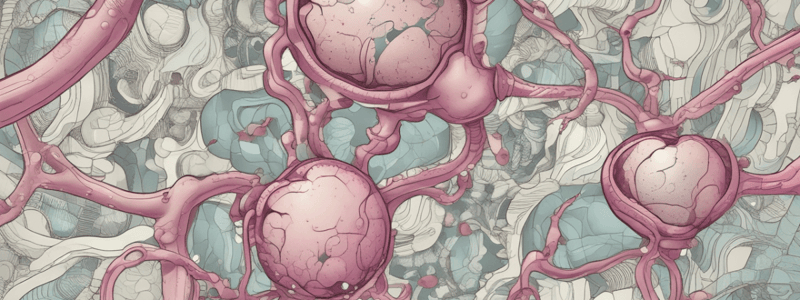Podcast
Questions and Answers
According to Boyle's Law, if the volume of a gas in a closed container is halved, what happens to the pressure?
According to Boyle's Law, if the volume of a gas in a closed container is halved, what happens to the pressure?
- It doubles. (correct)
- It stays the same.
- It is halved.
- It becomes zero.
What is the primary difference between ventilation and respiration?
What is the primary difference between ventilation and respiration?
- Ventilation occurs only during exercise, while respiration occurs all the time.
- Ventilation occurs in the lungs, while respiration occurs in the heart.
- Ventilation involves gas exchange, while respiration involves air movement.
- Ventilation involves air movement, while respiration involves gas exchange. (correct)
Which of the following factors does NOT affect the rate of pulmonary and systemic gas exchange?
Which of the following factors does NOT affect the rate of pulmonary and systemic gas exchange?
- Diffusion distance
- Temperature of the gas (correct)
- Partial pressure difference of the gases
- Surface area available for gas exchange
What percentage of CO2 in the blood is dissolved in the plasma as a gas?
What percentage of CO2 in the blood is dissolved in the plasma as a gas?
What is the form in which the majority of CO2 is transported in the blood?
What is the form in which the majority of CO2 is transported in the blood?
What is the primary factor that determines how much O2 binds to hemoglobin?
What is the primary factor that determines how much O2 binds to hemoglobin?
Where does external respiration occur?
Where does external respiration occur?
Which structure is NOT directly involved in the control of respiration?
Which structure is NOT directly involved in the control of respiration?
What is the primary function of Type I alveolar cells?
What is the primary function of Type I alveolar cells?
Which layer of the bronchial tree mucosa is responsible for secreting mucus?
Which layer of the bronchial tree mucosa is responsible for secreting mucus?
Which component is NOT found within a pulmonary lobule?
Which component is NOT found within a pulmonary lobule?
How do cilia function in the lower respiratory tract?
How do cilia function in the lower respiratory tract?
At what branching point do respiratory bronchioles begin and mark the start of the respiratory zone?
At what branching point do respiratory bronchioles begin and mark the start of the respiratory zone?
Which cells are responsible for secreting surfactant in the alveoli?
Which cells are responsible for secreting surfactant in the alveoli?
Which of the following is NOT a typical structural change in the bronchial tree?
Which of the following is NOT a typical structural change in the bronchial tree?
What happens to the epithelium as respiratory bronchioles give way to alveolar ducts?
What happens to the epithelium as respiratory bronchioles give way to alveolar ducts?
Which part of the respiratory system is located within the thorax?
Which part of the respiratory system is located within the thorax?
Which structure is NOT part of the lower respiratory tract?
Which structure is NOT part of the lower respiratory tract?
Which structure is a part of the conducting zone?
Which structure is a part of the conducting zone?
Which structure directly follows the trachea in the respiratory tract?
Which structure directly follows the trachea in the respiratory tract?
What is the main function of the respiratory zone?
What is the main function of the respiratory zone?
Which of the following is part of the internal nose?
Which of the following is part of the internal nose?
The trachea is located:
The trachea is located:
The larynx is also known as the:
The larynx is also known as the:
What is the main function of pulmonary arteries?
What is the main function of pulmonary arteries?
Which type of cell within the alveoli is responsible for gas exchange?
Which type of cell within the alveoli is responsible for gas exchange?
What does the pleural cavity contain?
What does the pleural cavity contain?
What is the main role of the surfactant in the alveoli?
What is the main role of the surfactant in the alveoli?
Where does the bronchial artery deliver oxygenated blood?
Where does the bronchial artery deliver oxygenated blood?
Which structure is not part of the respiratory membrane in the alveoli?
Which structure is not part of the respiratory membrane in the alveoli?
What divides the superior and inferior lobes of the left lung?
What divides the superior and inferior lobes of the left lung?
Which organ is adjacent to the pleural cavity on the right side?
Which organ is adjacent to the pleural cavity on the right side?
What causes vasoconstriction in the lungs during hypoxia?
What causes vasoconstriction in the lungs during hypoxia?
During pulmonary ventilation, which factor does not significantly influence the effort required for breathing?
During pulmonary ventilation, which factor does not significantly influence the effort required for breathing?
Study Notes
Alveoli
- The alveolus is the site of gas exchange, where CO2 is diffused out and O2 is diffused into the blood.
- Type I alveolar cells are simple squamous epithelial cells that form the site of gas exchange.
- Type II alveolar cells are cuboidal epithelial cells that secrete surfactant, which reduces surface tension.
- Alveolar macrophages remove dust and debris from the alveoli.
- Fibroblasts produce reticular and elastic fibers that provide structural support to the alveoli.
Pleura and Pleural Cavity
- The pleura is a double-layered membrane that surrounds the lungs and lines the thoracic cavity.
- The visceral pleura is the inner layer that adheres to the lungs, while the parietal pleura is the outer layer that lines the thoracic cavity.
- The pleural cavity is the space between the visceral and parietal pleura, which contains a small amount of fluid that reduces friction between the two layers.
Gross Anatomy of the Lungs
- The lungs are cone-shaped organs located in the thoracic cavity.
- The apex is the top of the lung, while the base is the bottom.
- The superior, middle, and inferior lobes are separated by the oblique and horizontal fissures.
- The cardiac notch is a indentation on the surface of the left lung that accommodates the heart.
Lung Blood Supply
- The lungs receive blood from two sets of arteries: pulmonary arteries and bronchial arteries.
- Pulmonary arteries carry deoxygenated blood from the right heart to the lungs for oxygenation.
- Bronchial arteries branch from the aorta and deliver oxygenated blood to the lungs, primarily perfusing the muscular walls of the bronchi and bronchioles.
Respiration
- Pulmonary ventilation is the movement of air between the atmosphere and the alveoli, consisting of inhalation and exhalation.
- External respiration is the exchange of gases between the alveoli and the pulmonary capillaries.
- Internal respiration is the exchange of gases between the systemic capillaries and the tissues.
Ventilation-Perfusion Coupling
- Blood flow to each area of the lungs matches the extent of airflow to the alveoli in that area.
- In response to hypoxia, vasoconstriction diverts pulmonary blood from poorly ventilated areas to well-ventilated regions.
Volume-Pressure Relationship
- The pressure of a gas in a closed container is inversely proportional to the volume of the container (Boyle's Law).
CO2 Transport
- CO2 is transported in the blood in three forms: dissolved in the plasma, converted into carbonic acid, and attached to hemoglobin (Hb).
O2 Transport
- O2 is transported in the blood attached to hemoglobin (Hb) and dissolved in the plasma.
- The most important factor that determines how much O2 binds to hemoglobin is the partial pressure of oxygen (PO2).
Control of Respiration
- The medulla oblongata, carotid body, and aortic bodies are responsible for controlling respiration.
- The respiratory center in the brain stem responds to changes in PO2 and PCO2 to maintain homeostasis.
Trachea and Bronchial Tree
- The trachea is a semi-rigid pipe made of cartilaginous rings that divides into the right and left primary bronchi.
- The bronchial tree is composed of 4 layers: mucous-secreting epithelium, submucosa, hyaline cartilage, and adventitia.
Pulmonary Lobule
- The pulmonary lobule is a functional unit of the lung that contains a lymphatic vessel, arteriole, venule, and terminal bronchiole.
- Respiratory bronchioles give way to alveolar ducts, which are lined with simple squamous epithelium.
Respiratory System
- The respiratory system is divided into upper and lower respiratory tracts.
- The respiratory system has two functional zones: the conducting zone, which brings air to the site of external respiration, and the respiratory zone, which is the site of gas exchange.
Studying That Suits You
Use AI to generate personalized quizzes and flashcards to suit your learning preferences.
Description
Identify the different components of an alveolus, including cells, membranes, and fibers, in a labeled diagram. Test your knowledge of respiratory anatomy!





